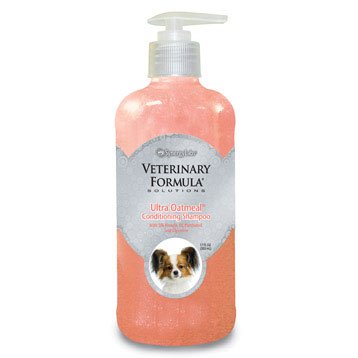- Lay down a mat in the tub for traction.
- Secure your dog, using a quick release leash and collar which you can attach to the soap dish. Nothing worse than a dog that jumps out of your tub running loose soaking wet and full of soap all over the house.
- Use a canine shampoo. One of our favorites is pictured to the right – Veterinary Formula Ultra Oatmeal Conditioning Shampoo. Measure out the amount you are intending to use and premix it with some warm water in old shampoo bottles saved for that purpose.
- Get some cotton balls ready to lightly pack the ears, so they stay dry.
STEP 1 -Adjust the water termparature. Test the water on the inside of your arm. Water that is too warm or too cold is a major cause of squiggly dogs.
STEP 2 -Put the dog in the tub, secure him, and thoroughly wet the dog. Work section by section…legs, feathering on the legs, underbelly, sides, front, bottom and tail. Leave the head until last. When you get to the ear, hold the flap down and use your hand as a shield against the ear canal to make sure the water doesn’t soak the cotton. If you want to moisten the eye, use a clean, soft cloth, not the shower nozzzle.
STEP 3 -Spread the shampoo evenly onto the dog’s coat. A word of caution: Cleaning the eye area should be done carefully by hand once the rest of the dog is done. Owners of prominent-eyed breeds need to be especially cautious…some shampoos can cause a burn or irritation if they get in the eye. Have some saline eye-rinsing solution handy in case you have an accident; even better, get some protective eye ointment from your veterinarian beforehand – it will help waterproof the eye and if you have to blow-dry a sensitive-eyed dog, it will keep the eye from drying out. Take the dog to the vet if you even slightly suspect you have damaged an eye during grooming or bathing. A damaged cornea is very painful for the dog snf will become infected – it needs immediate veterinary attention.
STEP 4 -Massage the shampoo into the coat and get a good lather. Rinse and repeat again.
STEP 5 -Rinse all shampoo out of the coat. Repeat the rinse one last time, even when you think the coat is shampoo-free. Shampoo residue can cause skin irritations – get it all out. Apply coat condtioners/rinses as directed. Some are leave-in, some are rinse-out. Always rinse in the direction of the coat.
STEP 6 -Using your hands in the direction of the coats, squeeze-out excess water. Let the dog shake. Then towel-dry the dog. You can be very vigorous with short-to-medium coated breeds but the long-coated breeds need careful blotting to avoid frizzy split ends and tangles.
STEP 7 -Air-drying is fine for a number of breeds, but some need careful blow-drying. Others need to be draped in special towels for drying, so the hairs stay straight and flat.
A QUICK TIP:
When it comes to dogs who come home with a coatful of burrs – the kind that stick like porcupine needles onto your dog’s hair – these miserable things tend to dig in deeper the harder you try to remove them. This is painful to your dog and will only drive you crazy. The easiest thing to remove them is to put your dog in the bathtub and with tepid (warm) water turn the water on them. The water will loosen the lot of them and they will fall off naturally.

